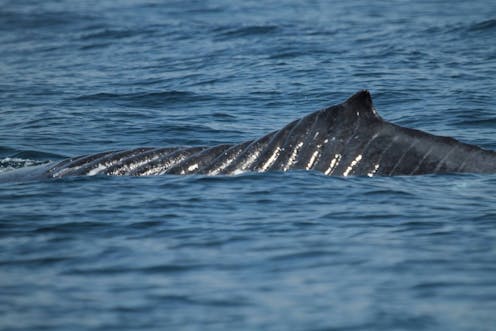The return of Bladerunner the humpback and Spilt Fin the killer whale – a cautionary tale about seafaring vessels
- Written by Vanessa Pirotta, Postdoctoral Researcher and Wildlife Scientist, Macquarie University

In the past few days, two well known survivors of the battle between marine mammals and vessels have been spotted in Australian waters. I’m talking about Bladerunner the humpback and Split Fin the killer whale[1]. Both have become famous for the massive scars they bear on their bodies, inflicted by boats.
Bladerunner is marked by a series of lines across her back and part of her tail. These lines were made by a propeller in motion. Spilt Fin, as her name suggests, has a split dorsal fin – likely also caused by a boat propeller.
I’m lucky to have seen both during my career studying whales. I first saw Bladerunner in 2013 while conducting research off Cape Solander, Sydney. And I spotted Spilt Fin and her pod on a whale watching trip off Eden, New South Wales, back in 2009.
I get a buzz every time I hear about another sighting. I know countless other people feel the same way. But there’s another feeling, too, knowing they were hurt yet narrowly avoided a fate far worse. So let’s take this opportunity to learn a bit more about these majestic creatures and how to keep them safe from harm.
What happened to Bladerunner and Split Fin?
Bladerunner and Split Fin sustained terrible injuries quite some time ago now. Bladerunner was struck in 2001[2] and Spit Fin was first spotted in 2003. In both cases, the wounds healed without becoming infected.
Killer whales, such as Split Fin, are actually the largest members of the dolphin family[3]. Whales and dolphins swim to the surface to breathe[4]. They may also feed and socialise at the surface, where they’re highly likely to encounter a vessel.
A collision in the ocean is called vessel strike[5] (sometimes ship strike or boat strike).
Unfortunately, whales and dolphins are at risk of vessel strike worldwide[6]. In some cases, whales may be fatally wounded or sustain terrible injuries[7] that restrict movement and leave them unable to swim properly. This makes them more vulnerable to predators such as killer whales.
Bladerunner and Split Fin look different, so people notice them
It’s impossible for scientists to be out on the ocean all the time, so it’s helpful when other people spot whales travelling on the “humpback highway”. For example:
Bladerunner was sighted by people onshore at Tathra, NSW, on Wednesday, and filmed using a drone :
Split Fin and her pod were spotted off Eden last week from a whale-watching platform:
Both humpback whales and killer whales can live for well over 50 years, so hopefully we can enjoy many more sightings.
Dedicated “citizen scientists” capture sightings on social media through groups such as Killer Whales Australia[8]. There’s also various “whale-y” fun local projects, right around Australia, where you can get involved[9].
In addition, my team and I are documenting unique humpback whale sightings including the elusive white humpback whale Migaloo[10]. Being all white makes him stand out, so people tend to notice him. But it’s been four years between sightings[11] now. When will Migaloo turn up next?
A reminder to please keep your distance
Both Bladerunner and Split Fin remind us all to take care when on the water, or flying a drone over the ocean.
All whales, dolphins and porpoises in Australian waters are protected[12]. The authorities have rules in place to keep these animals safe.
As a general rule, please keep your distance on the water by staying at least 100 metres away from whales. If a calf is present, the “exclusion zone” extends out to 300 metres[13].
If you’re flying a drone[14], that means the drone must fly at least 100m or higher above the ocean’s surface.
Ensuring we don’t get too close will allow these creatures safe passage in our waters, so we can continue to enjoy them.
Of course, vessel strike is not the only threat whales and dolphins face. Human activities present other dangers such as entanglement in fishing gear[15], noise[16] and other forms of pollution, climate changes, and underwater construction to name a few. The good news is science is helping us understand these threats, so we can make evidence-based decisions to better protect these creatures in the future.
Bladerunner is back!Tail end
Bladerunner is one of more than 40,000 humpbacks currently migrating north to warmer waters from Antarctica. They’re on their way to a fun place I call the “whale disco[17]”, where male humpback whales sing[18] and socialise with females. Humpback females may give birth or fall pregnant during this time.
It’s a special time of year, when all eyes are on the big blue.
Let’s hope for safe passage for all whales and dolphins, as they enjoy Australian waters.
This article was drawn from material in Vanessa Pirotta’s new book Humpback Highway: Diving into the mysterious world of whales[19].
References
- ^ Split Fin the killer whale (www.abc.net.au)
- ^ struck in 2001 (www.abc.net.au)
- ^ the largest members of the dolphin family (australian.museum)
- ^ surface to breathe (theconversation.com)
- ^ vessel strike (www.sciencedirect.com)
- ^ vessel strike worldwide (esajournals.onlinelibrary.wiley.com)
- ^ sustain terrible injuries (www.theguardian.com)
- ^ Killer Whales Australia (www.facebook.com)
- ^ where you can get involved (www.abc.net.au)
- ^ Migaloo (www.migaloo.com.au)
- ^ four years between sightings (meridian.allenpress.com)
- ^ protected (www.agriculture.gov.au)
- ^ the “exclusion zone” extends out to 300 metres (www.environment.nsw.gov.au)
- ^ flying a drone (www.theguardian.com)
- ^ entanglement in fishing gear (theconversation.com)
- ^ noise (www.tandfonline.com)
- ^ whale disco (theconversation.com)
- ^ male humpback whales sing (pubs.aip.org)
- ^ Humpback Highway: Diving into the mysterious world of whales (unsw.press)

















